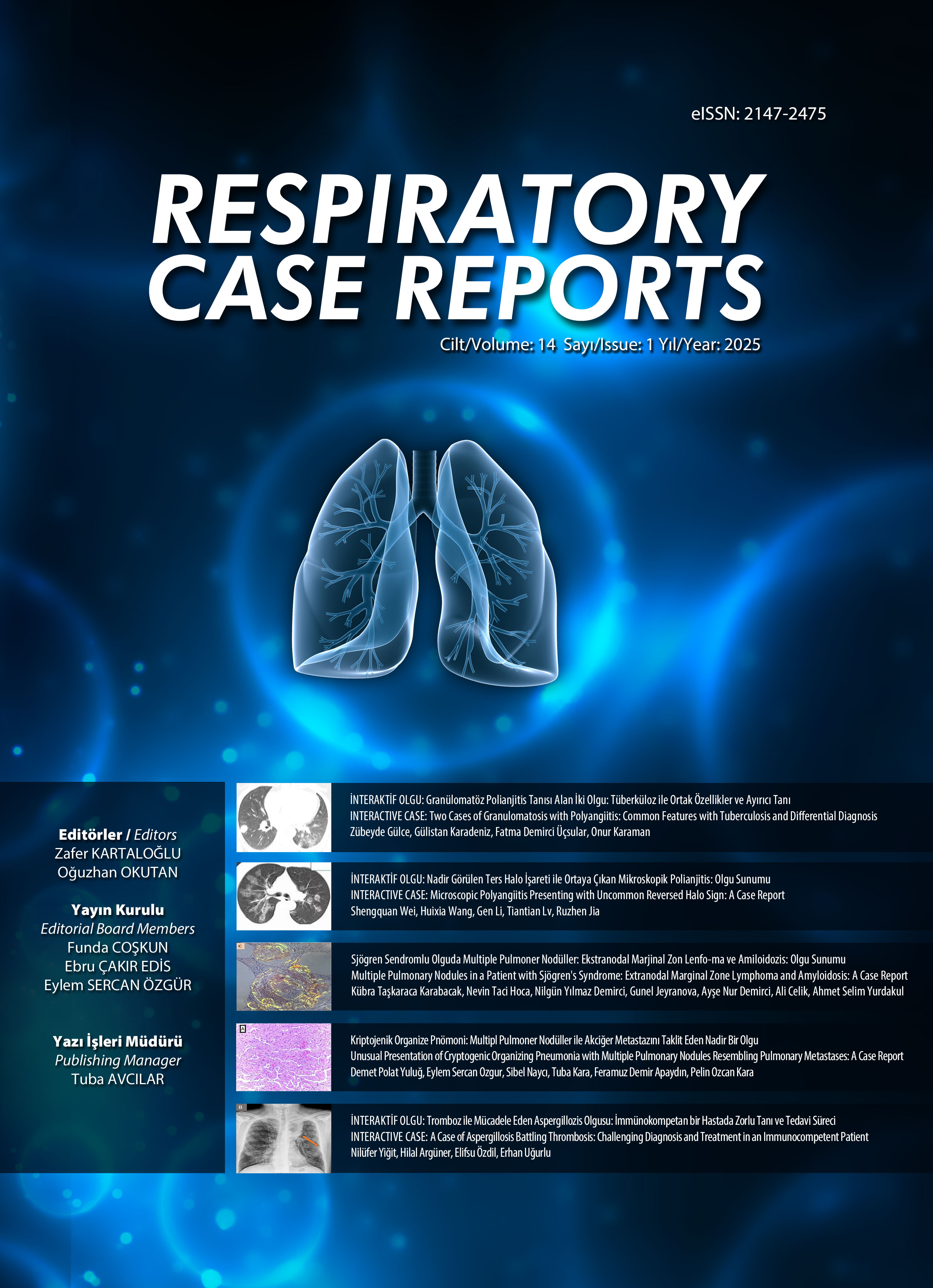e-ISSN 2147-2475

Volume: 5 Issue: 1 - February 2016
| CASE REPORT | |
| 1. | INTERACTIVE CASE REPORT: A Case of Dental Prosthesis Aspiration in a Patient with Tracheostomy Nurhan Atilla, Hüseyin Arpağ, Şemi Atilla, Ilim Irmak, Ahmet Beyaz doi: 10.5505/respircase.2016.54938 Pages 1 - 4 A 49-year-old male patient was hospitalized to our chest intensive care unit with the diagnosis of recurrent pneumonia. Following a traffic accident five years previously the patient was quadriplegic and had a tracheostomy tube. His physical examination revealed widespread expiratory rhonchi and intercostal retractions. Right lower lobe atelectasis, and also a foreign body at the entrance of the right lower lobe, was seen with a posteroanterior chest x-ray and thoracic computed tomography. We saw that the foreign body was present at the chest x-ray performed immediately after the accident. It is probable that dental trauma occurred during intubation. In a fiberoptic bronchoscopy, a foreign body was identified in the proximal part of the right lower bronchus; a second foreign body was seen at the segment level. The foreign bodies were removed using an alligator biopsy forceps without damaging the surrounding tissue; there were no complications. The foreign bodies were teeth and a dental prosthesis. In conclusion, in patients who have sustained facial or dental trauma, including traumatic intubations, and who have a missing tooth, it must be presumed that the tooth has been aspirated, and radiographic evaluation is needed. |
| 2. | Birt-Hogg-Dubé Syndrome: CT Findings of an Under Recognized Disease Requiring Multidisciplinary Approach Canan Cimsit, Emel Eryuksel, Nuri Cagatay Cimsit, Sehnaz Olgun, Dilek Seckin, Merve Hatun Saricam, Cuyan Demirkesen doi: 10.5505/respircase.2016.76476 Pages 5 - 9 Birt-Hogg-Dubé Syndrome (BHDS) is characterized by hair follicle hamartomas, renal tumors, and pulmonary cysts. In this case series, CT findings of two index patients with BHDS, and their family members, are presented. Differential diagnosis with other cystic lung diseases is discussed. The importance of follow-up and screening for the early detection of possible malignancies, as well as multidisciplinary approach, is emphasized. The course of BHDS requires not only annual patient follow-up but also care due to the risk of pneumothorax. |
| 3. | A Patient with Organizing Pneumonia Development During the Use of Capecitabine Maintenance Treatment for Gastric Cancer Gökmen Aktaş, Tülay Kuş, Mehmet Emin Kalender, Kemal Bakır, Celaletdin Camcı doi: 10.5505/respircase.2016.32559 Pages 10 - 14 Organizing pneumonia (OP) is an inflammatory process of the bronchioles that can lead to destruction of small airways and surrounding lung tissue. Secondary OP, caused by anti-cancer drugs and radiotherapy, has previously been reported. In this study, we report the case of a 60-year-old female patient presented with OP, while using low dose capecitabine maintenance for stage IV gastric cancer under remission. After 18 months of routine follow-up with computed tomography (CT), a 9 mm subpleural nodule was presented at the right lung upper lobe posterior segment. Wedge resection was performed. Based on histopathologic examination, a diagnosis of OP was confirmed. In this instance, capecitabine was implicated as the likely cause of this drug-induced lung toxicity. This patient is the first case associated with development of OP during capecitabine monotherapy. |
| 4. | ATRA Syndrome During the Treatment of Acute Myeloid Leukomia (AML-M3) Tuğba Önyılmaz, Serap Argun Barış, İlknur Başyiğit, Ayfer Gedük doi: 10.5505/respircase.2016.75537 Pages 15 - 17 Following the advent of all-trans retinoic acid (ATRA), acute promyelocytic leukemia (APL) is the most curable form of acute myeloid leukemia. However, all trans-retinoic acid (ATRA) syndromes can occur during the treatment by ATRA. ATRA syndrome is characterized by fever, respiratory distress, pulmonary infiltrations, pleural and pericardial effusion, hypotension, and acute renal failure. Here, we presented a patient with ATRA syndrome, admitted with dyspnea, pretibial edema and pleural effusion, who fully recovered in a short time following dexamethasone 2x8mg IV treatment. |
| 5. | INTERACTIVE CASE REPORT: Lymphoma Case Mimicking Tuberculosis Emel Bulcun, Aydanur Ekici, Mehmet Ekici, Nesime Günal doi: 10.5505/respircase.2016.83997 Pages 18 - 21 We present here the case of a female patient with T cell rich diffuse large B cell lymphoma (DLBL), since it is hard to differentiate from tuberculosis, both clinical and radiological features were considered. A 43- year-old female patient had complaints of dyspnea, cough, sweating, and anorexia for the previous three months. In the thorax CT, there were anterior mediastinal mass lesions, and right pleural, pericardial effusion. She had bilateral supraclavicular lymphadenopathy. Fluid cytology was negative for malignancy. The pathology of the lymph node was caseified granuloma in appearance, compatible with tuberculosis. Since her clinical findings were not compatible with tuberculosis, multibiopsy was performed in mediastinal mass. According to the biopsy, the disease was compatible with tuberculosis. Standard antituberculosis treatment was initiated. By the second month of treatment, no regression was observed with thorax CT. Her biopsy preparations were reevaluated. The patient had T cell rich DLBL. In conclusion, as with other malignancies, lymphomas also cause granulomatous reaction. Therefore, it may be hard to differentiate from tuberculosis. |
| 6. | INTERACTIVE CASE REPORT: Recurrent Pneumonia Caused by The Aspiration of a Quad Dental Prosthesis, Late Diagnosed and Treated with Rigid Bronchoscopy Hüseyin Lakadamyalı, Berna Devrim Yağbasan, Tülay Kıvanç doi: 10.5505/respircase.2016.37232 Pages 22 - 24 Foreign body aspiration is a very serious and critical problem. It may cause chronic and irreversible lung injury and occasionally lead to sudden death. Early diagnosis is key to the prevention of complications. Although the aspiration of teeth and dental repairs is a recognized event, it is only rarely reported in the literature. The main reasons for aspiration are maxillofacial trauma, dental treatment procedures or alcohol/ ethanol intoxication and dementia. We report a case of dental treatment the lead to aspiration of a quad dental prosthesis, with delayed diagnosis and complications. |
| 7. | INTERACTIVE CASE REPORT: A Case Report of Thyroid Cancer who Followed an Asthma Diagnosis Sinem Nedime Sökücü, Cengiz Özdemir, Seda Tural Önür, Levent Karasulu, Levent Dalar doi: 10.5505/respircase.2016.48278 Pages 25 - 29 Many patients with airway stenosis are misdiagnosed for a long period. The reason for the airway obstruction in these patient can be due to benign pathology as well as secondary malignant disease. If not recognized early, it can reach life-threatening dimensions. A 50-year-old female patient was admitted with a five-year following the diagnosis of asthma with progressive shortness of breath. Bronchoscopic evaluation revealed a smooth surface structure with rich vascularity 2 cm distal to the vocal cords sitting with a large base of over the right anterolateral wall and obstructing the lumen by 90%. Core out was applied following diode laser photocoagulation of the proximal mass and afterwards a 16x14x16 stenotic stent was positioned. The tracheal biopsy pathology was established a thyroid carcinoma. The distally migrated stent was removed with scheduled surgery. The patients thyroidectomy pathology identified a papillary thyroid carcinoma. Following thyroidectomy, the patient was observed without any complication. It is important to underwent differential diagnosis with advanced techniques in patients without clinical relief, despite prolonged bronchodilator treatment for obstructive airway disease. |
| 8. | INTERACTIVE CASE REPORT: A Case of Idiopathic-Bilateral Chylothorax İbrahim Güven Çoşğun, Bayram Metin doi: 10.5505/respircase.2016.05706 Pages 30 - 33 Chylothorax is the collection of lymphatic fluid in the pleural space. Lymphatic fluid in the pleural space may cause metabolic and immunologic disorders. Trauma to the thoracic duct and malignant disease (non-Hodgkins lymphoma) are the common mechanisms of chylothorax. Other rare causes are lymphangiomyomatosis, tuberculosis, venous thrombosis, congenital lymphatic malformations, nephrotic syndrome, hypothyroidism, cirrhosis and idiopathic chylothorax. A 56-year-old woman presented with dyspnea, reduced appetite and weight loss. A chest x-ray showed left homogenoeus density with a concave interface toward the lung and blunting of right costophrenic angle. Thoracentesis was performed. Milky off-white fluid was aspirated. Analysis of the fluid confirmed the diagnosis of chylothorax. Etiology was not determined. Chylothorax was regressed with conservative treatment. We present a case of rare bilateral-idiopathic chylothorax with regression following conservative therapy. |
| 9. | Sarcoidosis Imitating Sjögren's Syndrome or the Association of Sarcoidosis - Sjögren's Syndrome Özlem Erçen Diken, Aydın Çiledağ, Çetin Atasoy, Özlem Özdemir Kumbasar doi: 10.5505/respircase.2016.64325 Pages 34 - 37 Sarcoidosis and Sjögrens syndrome are chronic multi-systemic diseases. The association of these two diseases was reported only in 1% of patients with Sjögrens syndrome. We present this rare case in order to draw the attention to the prognostic importance of this difference. A 62-year-old female patient presented to our hospital with the complaints of dyspnea and a dry cough. Dry eye and dry mouth were present. Laboratory analyses revealed serum anti SS-A (Ro) (+++) antibody positivity. Chest computerized tomography revealed lymphadenopathy and reticular-micronodular appearance evident. Transbronchial needle aspiration guided with endobronchial ultrasound was conducted through 10R and 7 lymph nodes. Pathology was compatible with sarcoidosis. Pulmonary function test revealed 40% carbon monoxide diffusion capacity. It is of prognostic importance to distinguish sarcoidosis imitating Sjögrens syndrome from the association of sarcoidosis- Sjögrens syndrome, since sarcoidosis mostly limits itself and recover by itself without any functional restrictions, but the pulmonary involvement of Sjögrens syndrome causes permanent defects. |
| 10. | Pulmonary Langerhans Cell Histiocytosis Imitating Metastatic Lung Carcinoma Funda Coşkun, Feyza Sen, Ahmet Ursavas, Ahmet Sami Bayram, Ömer Yerci, Sinem Kantarcıoğlu Coşkun, Eray Alper, Mehmet Karadağ doi: 10.5505/respircase.2016.78309 Pages 38 - 42 Pulmonary Langerhans cell histiocytosis (PLCH) is a rarely seen disease. We think our case is worthy of publication due to its presentation with anamnesis and clinical findings very similar to metastatic pulmonary carcinoma, from the patients admittance to the clinic until the thoracosopic evaluation. A 40-year-old male patient was admitted with a compliant of lower back pain. Five or six round lesions with regular contours in both lungs on the left and lower zone, the largest with dimension of 2cm, were observed on the patients thoracic CT examination. During bronchoscopy, a vegetant tumoral mass was detected in left lower lobe apical segment. Mucosal tissue samples containing pseudostratified respiratory epithelium, seromucous glandular structures in the submucosa, surrounding eosinophilic leukocytes and lymphoplasmocytic inflammatory infiltration were detected in the transbronchial biopsy. Significantly increased FDG enhancement was observed in the posteromedial pleural based mass located in the left lung lower lobe bronchus contiguity in the PET-CT examination (SUVmax: 14.9). Wedge resection was performed, as the diagnosis was not established following bronchoscopy examinations. Pathological diagnosis was compatible with PLCH. We thought our case worthy publication as the disease is seen rarely in adulthood and furthermore the clinical presentation imitated pulmonary carcinoma. |
| 11. | INTERACTIVE CASE REPORT: Sevoflurane-related Isolated Pulmonary Vasculitis: A New Etiological Cause of Diffuse Alveolar Hemorrhage? Ufuk Turhan, Mehmet Aydoğan, Erol Kılıç, Hatice Kaya, Alper Gündoğan, Yıldırım Karslıoğlu, Ergün Uçar, Hayati Bilgiç doi: 10.5505/respircase.2016.86658 Pages 43 - 48 Pulmonary capillaritis is the small-vessel vasculitis of the lungs. We report a case of isolated pulmonary capillaritis presenting with diffuse alveolar hemorrhage, which is not associated with ANCA. The patient had shortness of breath that developed after myomectomy surgery: sevoflurane was used as a general anesthetic in the operation. The thorax HRCT scans showed ground glass opacities in both lungs and consolidation in the right lower lobe. Due to hemorrhagic and darkening of the BAL fluid as aspirated, it was thought that the diagnosis was in accordance with alveolar hemorrhage. The patient responded well to methylprednisolone therapy. The transbronchial lung biopsies revealed vasculitis. ANCA and other rheumatologic markers were negative. Due to the absence of systemic symptoms, we diagnosed ANCA negative isolated pulmonary capillaritis. Rapid diagnosis and pulse steroid therapy are of vital importance in these patients. It should be kept in mind that inhalation anesthetics could be responsible for cases of DAH and SPC. |
| 12. | A Rare Complication related with Oral Anticoagulant Use: Diffuse Alveolar Hemorrhage (Over 65 Years; Four Case Reports) Serap Duru, Bahar Kurt, Merve Yumrukuz, Esra Erdemir doi: 10.5505/respircase.2016.83723 Pages 49 - 52 Diffuse alveolar hemorrhage (DAH) caused by immune and non-immune etiological factors, characterized by diffuse alveolar consolidation, often presents with the clinical triad of dyspnea, hemoptysis and, anemia, as a result of the disruption of the alveolocapillary membrane of the lung. We present four cases, when the patients are over 65 years of age, followed up at our clinic with diffuse alveolar hemorrhage as a rare complication of the uncontrolled use of anticoagulant (Warfarin) therapy. |
| 13. | Rheumatoid Arthritis and Pulmonary Embolism: A Report of Three Cases Dicle Kaymaz, Pınar Ergün, Ipek Candemir doi: 10.5505/respircase.2016.77150 Pages 53 - 56 Rheumatoid arthritis (RA) is the most commonly encountered inflammatory joint disease, affecting nearly 1% of the adult population. RA is not generally viewed as a risk factor for deep venous thrombosis and pulmonary embolism, although patients with RA are at an increased risk of venous thromboembolism. We present three cases of RA with the diagnosis to draw attention in this issue. |
| 14. | Traumatic Lung Herniation Göktan Temiz, Suat Gezer doi: 10.5505/respircase.2016.95867 Pages 57 - 59 Lung hernias are seen rare. It is defined as the protrusion of lung tissue covered by pleurae through in the thoracic wall. They can be either congenital or acquired in origin. Here we report a case of lung hernia due to heavy lifting. |
| 15. | Pulmonary Cystic Hamartoma Göktan Temiz, Suat Gezer doi: 10.5505/respircase.2016.97759 Pages 60 - 62 Pulmonary hamartoma is the most common benign neoplasm of the lung. Its size is usually smaller than 4 cm, and a pulmonary hamartoma larger than 10 cm is rare. Pulmonary hamartoma with air-filled cystic areas is also an unusual form. Since it is a rare condition, in this article, we reported a case of pulmonary cystic hamartoma in a 56-year-old patient admitted with a cough and breathing difficulties. |
| 16. | INTERACTIVE CASE REPORT: Intrathoracic Desmoid Tumor: A Rare Localization Erkan Akar, Taşkın Erkinüresin, Fatin Tolga Cengiz doi: 10.5505/respircase.2016.07269 Pages 63 - 66 Desmoid tumors are histologically benign, however locally aggressive, tumors. They are rare tumors that develop from fibrocytes, connective tissue fascia and musculoaponeurotic fibrous tissues. They are rarely found in thoracic wall and are treated like malignant tumors. Surgery is the most effective and foremost treatment. The chest x-ray of a 57-year-old female patient, who complained of severe shoulder and back pain showed an abnormality in right lung upper zone. The mass was totally excised. The patient had no post-operative problem and was discharged on the post-operative seventh day. Based on pathologic analysis, the diagnosis was reported to be a desmoid tumor. |
| 17. | Mediastinal Castleman's Disease: A Report of Case and Review of the Literature Göktan Temiz, Suat Gezer, Muharrem Özkaya doi: 10.5505/respircase.2016.48569 Pages 67 - 70 Castlemans disease is a rare benign disease with an unknown etiology. Although it is more common in adults, it can be seen at any age starting from childhood. Although more commonly observed in the thorax, it can be found anywhere in the body. It is usually localized in the middle or anterior mediastinum. With a review of the literature, we hereby introduce a case of Castlemans disease, excised in prediagnosis as a teratoma. |
| 18. | Sleep Respiratuar Disorder in A Child with Congenital Bone Dysplasias: A Case of Report Melike Batum, Ayşın Kısabay, Sinem Oğuz, Bilge Oktan, Hikmet Yılmaz doi: 10.5505/respircase.2016.82905 Pages 71 - 74 Achondroplasia is the most common form of congenital bone dysplasia, which is inherited, autosomal dominantly and characterized by cervicomedullary compression, infarction of the spinal cord, nerve root compression, and respiratory disorders during sleep. A 12-year-old patient with a diagnosis of achondroplasia was presented with complaints of snoring, sleep apnea, and lethargy. Upon finding severe obstructive sleep-apnea syndrome with polysomnography, the patient received titration with the support of two-level positive airway pressure and apneahypopnea index regressed. The patient was discharged with position and support from two-level positive airway pressure. |
| LETTER TO EDITOR | |
| 19. | Salbutamol - İpratropium Bromür Nebülizasyonuna Bağlı Anizokori Zülal Özbolat, Levent Özdemir, Burcu Özdemir, Merih Gül, Gülsün Gül doi: 10.5505/respircase.2016.72621 Pages 75 - 76 Abstract | |











